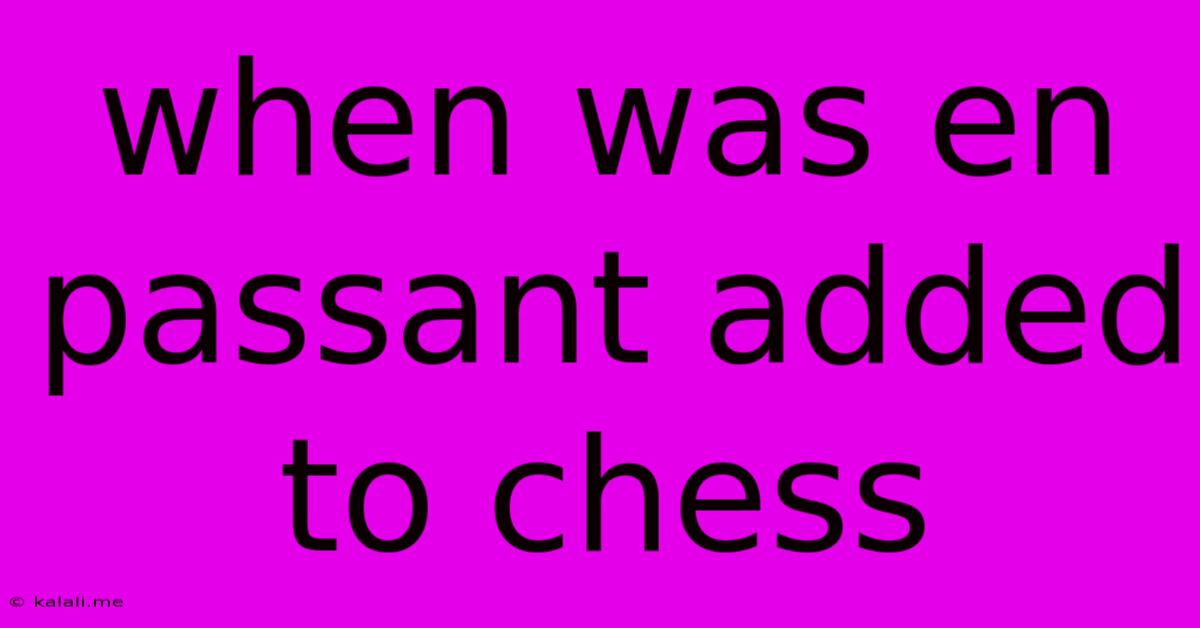When Was En Passant Added To Chess
Kalali
Jun 03, 2025 · 3 min read

Table of Contents
When Was En Passant Added to Chess? A Deep Dive into Chess History
The en passant rule, a quirky and often misunderstood aspect of chess, adds a layer of strategic complexity rarely seen in other board games. But when did this unique capture method enter the world of chess? Understanding its history provides insight into the evolution of the game itself. This article delves into the historical context of en passant, exploring its origins and the reasons behind its inclusion.
The Early Days of Chess and the Absence of En Passant
Chess, in its earliest forms, lacked the en passant rule. The game evolved over centuries, travelling from India through Persia and into Europe, constantly undergoing changes and refinements. Early variations of the game, such as chaturanga, didn't include this specific capture mechanic. These early forms focused on the straightforward movement and capture of pieces. The pawn's two-square advance on its first move was present, but the opportunity to capture it en passant was not.
The Development of Modern Chess and the Emergence of En Passant
As chess began to solidify into its modern form, the need for a rule addressing the unique pawn advance became apparent. The two-square move on a pawn's first turn presented a loophole that could be exploited. An opponent could move their pawn two squares forward, potentially bypassing a diagonally adjacent pawn that would normally have the right to capture it. This was deemed unfair and unbalanced, leading to the creation of en passant.
Pinpointing the Exact Date: A Difficult Task
Unfortunately, there isn't a precise date etched in stone marking the official introduction of en passant. Its adoption was a gradual process, evolving alongside the standardization of chess rules. However, its incorporation into the rules likely occurred sometime during the 15th or 16th centuries. Various rule books and manuscripts from this period showcase increasingly refined versions of the game, with many eventually including the en passant rule.
Why En Passant Was Added: Addressing an Imbalance
The primary reason for incorporating en passant was to address a strategic imbalance created by the pawn's initial two-square move. Without this rule, a player could exploit this move to prevent an otherwise valid capture, hindering the opponent's ability to develop their pieces effectively. En passant, therefore, serves as a crucial component in maintaining the game's balance and fairness. It prevents the two-square advance from becoming an overly powerful tactic, adding another layer to the strategic depth of the game.
En Passant Today: A Continuing Element of Chess Strategy
Today, en passant remains a key element of chess strategy, albeit one that often goes unused or even forgotten by less experienced players. Its infrequent occurrence does not diminish its significance. Mastering en passant and understanding its implications are important for those aiming for higher levels of play. Its presence highlights the continuous evolution of chess rules to ensure fairness and a challenging yet balanced gameplay experience. The addition of en passant significantly improved the fairness and complexity of the game, shaping it into the strategic masterpiece we know today.
Latest Posts
Latest Posts
-
A Cord Of 3 Strands Bible Verse
Jun 05, 2025
-
Wood Logs Vs Charcoal Efficiency Minecraft
Jun 05, 2025
-
How To Increase Energy Of A Sound Wave
Jun 05, 2025
-
How To Check A Fuel Regulator
Jun 05, 2025
-
How To Make Custom Mouse Button Action Macos
Jun 05, 2025
Related Post
Thank you for visiting our website which covers about When Was En Passant Added To Chess . We hope the information provided has been useful to you. Feel free to contact us if you have any questions or need further assistance. See you next time and don't miss to bookmark.